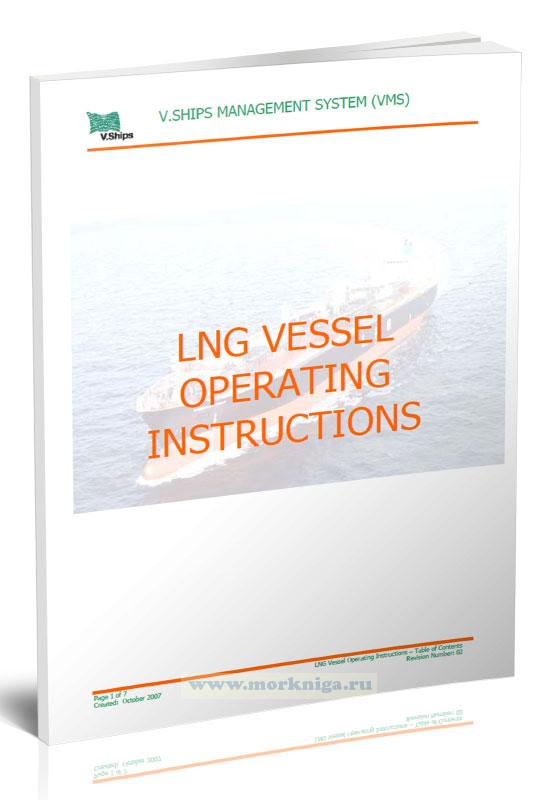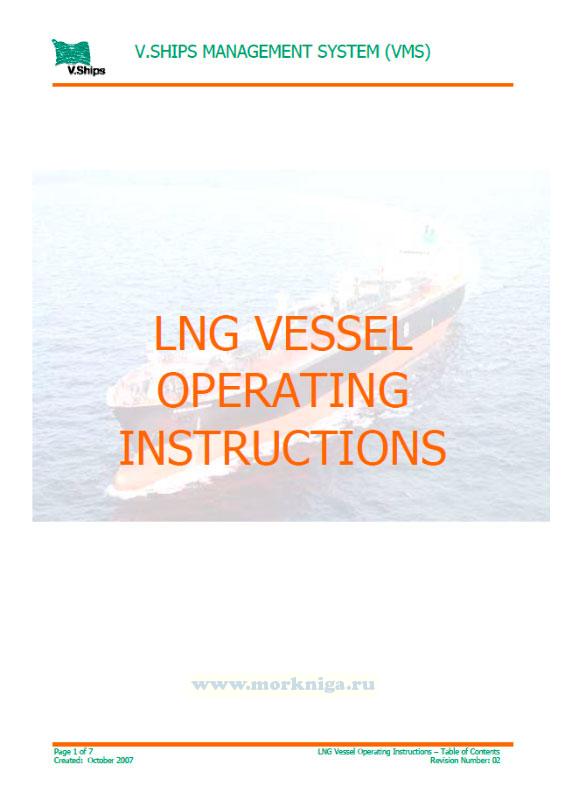LNG Vessel Operating Instructions/Инструкция по эксплуатации судов для перевозки сжиженного природного газа
Книга на английском языке.
This Manual is issued in accordance with the Company's VMS and contains specific instructions etc. based on V Ships operating experience. The subject matter was selected where the Company considered that emphasis had to be placed on the relevant operational procedures, precautions, instructions etc. It is the policy of V.Ships, that all cargo operations are carried out in a controlled and safe manner in accordance with Company operating procedures as laid down in the V.Ships Safety Management System. These procedures are based on industry best practices as referenced in the publications listed in this manual. The following procedures are intended to lay down minimum standards and to serve as guidelines for the safe operation of the vessel. Should there be any conflict between the procedures and diagrams in this manual, and those in the ship specific cargo operating manuals, then the cargo operating manual is to take precedence.
Contents
1.0 General
1.1 Definitions
1.2 Introduction
1.3 Departure from these procedures
1.4 VMS Manuals
1.5 Reference publications
1.6 Checklists
1.7 Gas Tanker Forms
2.0 Responsibility
2.1. General Requirements for LNG Vessels
2.2 Master
2.3 Chief Officer
2.3.1 Chief Officer's Cargo Plans and Standing Orders
2.3.2 Loading / Stress Computers
2.4 Deck Officers
2.5 Chief Engineer
2.6 Cargo Engineer
2.7 Electrical Engineer
2.8 Deck Crew Members
2.9 In Port Watchkeeping Procedures
2.10 In Port Watch Handover Procedures
3.0 Properties of LNG
3.1 Physical Properties, Composition and Characteristics of LNG
3.2 Composition of LNG
3.3 Physical Properties of LNG
3.4 Properties of Methane
3.5 Variation of Density with Temperature
3.6 Variation of Boiling Point of Methane with Pressure
3.7 Boiling Point Methane with Pressure
3.8 Flammability of Methane, Oxygen and Nitrogen Mixtures
3.9 Characteristics of LNG
3.10 Using the Diagram
3.11 Supplementary Characteristics
3.11.1 When spilled on Water
3.11.2 Vapour Clouds
3.12 Reactivity
3.13 Cryogenic Temperatures
3.14 Behaviour of LNG in the Cargo Tanks
3.15 Properties of Nitrogen and Inert Gas
3.15.1 Nitrogen
3.15.2 Physical Properties of Nitrogen
3.15.3 Properties of Nitrogen
3.15.4 Chemical Properties
3.15.5 Hazards
3.16 Inert Gas
3.17 Avoidance of Cold Shock to Metal
3.17.1 Structural Steel Ductile to Brittle Transition Curve
3.18 Spillages
3.19 Vapour Pressure, Specific Gravities and Heat of Vaporization of Methane
4.0 LNG Vessel Construction
4.1 Cargo Containment Systems
4.2 Membrane cargo Containment
4.2.1 Deterioration or Failure of the Insulation System
4.2.2 Inner Hull Inspections (Membrane Containment)
4.3 Moss Rosenberg Containment
4.4 Leak Detection
4.5 Cargo Piping System
4.5.1 Liquid Lines
4.5.2 Vapour Lines
4.5.3 Spray Lines
4.5.4 Fuel Gas Line
4.5.5 Vent Line
4.5.6 Inerting / Aeration Line
4.6 Ship and Berth Compatability
5.0 LNG Vessel Cargo Equipment
5.1 Inert Gas and Dry Air Generator
5.2 Nitrogen Generator
5.3 Cargo/Spray Pumps
5.4 Compressor (High & Low Duty)
5.5 Cargo Heater (High & Low Duty)
5.6 LNG Vaporizer
5.7 Forcing Vaporizer
5.8 Mist Separator
5.9 Vacuum Pumps
5.10 Fixed Gas Detection System
5.11 Emergency Shut Down (ESD) and Cargo Tank Protection
5.11.1 Emergency Shut Down (ESD) - Blocking and Override
5.12 Ship Shore Link
5.13 Relief Systems
5.14 Cargo Tank Gauging System
6.0 Safety
6.1 Fire Fighting
6.1.1 Dry Powder
6.1.2 Water Extinguishing
6.1.3 CO2
6.2 Access
6.2.1 Means of access (gangways or accommodation ladders)
6.2.2 Lighting
6.2.3 Un-authorized persons
6.2.4 Persons smoking, intoxicated or drugged
6.3 Notices
6.3.1 Permanent
6.3.2 Temporary
6.4 Craft Alongside
6.5 Dispersal of Vented Cargo Vapours
6.6 Air Conditioning, Ventialtion and Openinga in Deckhouses and Superstructures
6.7 Weather Precautions
6.7.1 Wind Conditions
6.7.2 Electrical storms
6.8 Engine and Boiler Room Precautions
6.9 Trim, Stability, Stress and Readiness to Move
6.10 Helicopters
6.10.1 Types of Operating Areas
6.10.2 Design Limitations
6.10.3 Vapour Emission Control
6.11 MSDS Nitrogen and Methane
6.12 Hazards Associated with Natural Gas Vapours
6.13 Personnel Protection
6.14 Exposure
6.15 Overriding of ship safety systems
7.0 Company Standing Orders - Deck/Cargo Operations
8.0 Planning Cargo Operations
8.1 Cargo Handling Planning - Appraisal Phase
8.2 Cargo Handling Planning - Planning Phase
8.3 Cargo Planning - Loading Operation Guidelines
8.4 Cargo Planning - Unloading Operation Guidelines
8.5 Cargo Planning - Cargo Operation Guidelines
8.6 Cargo Handling - DuringOperations
8.7 Cargo Handling - Recording
9.0 Cargo Operations
9.1 Drying Tanks
9.2 Inerting Prior to Gassing Up
9.3 Gassing Up Cargo Tanks
9.4 Cooling Down Cargo Tanks
9.5 Before arrival at a Terminal (Both Loading and Discharging)
9.5.1 ESD Testing
9.6 Preparation for Loading
9.7 Loading Cargo
9.7.1 Cooling Cargo Lines
9.7.2 Bulk Loading
9.7.3 Topping off
9.7.4. Deballasting
9.8 Loaded Passage
9.9 Preparation for Discharging
9.10 Discharging Cargo
9.10.1 Discharging Without Vapour Return
9.10.2 Cargo Heel
9.10.3 Draining/Purging
9.11 Ballast Passage
9.12 Warming up Cargo Tanks
9.13 Inerting Cargo tanks
9.14 Aerating Cargo Tanks
9.15 Sloshing and the partial Filling Filling of Cargo Tanks
9.15.1 Design, Modifications and Improvements
9.15.2 Filling Limits
10. Emergency Procedures
10.1 Emergency Procedures
10.1.1 Communications
10.1.2 Emergency response Room numbers
10.1.3 Dealing with the Media
10.2 Firefighting Procedures
10.2.1 General Information
10.2.2 Liquid Fires
10.2.3 Solid Fires
10.2.4 Electrical Fires
10.3 Fire Involving Liquefied Natural Gas Cargo
10.4 Procedure to Follow in the Event of a Fire
10.5 Procedure to Follow in event of Compressor / Motor Room Fire
10.6 Procedure Following a Collision - General Information
10.6.1 Collision - No Apparent Rupture of Cargo Tank (Membrane)
10.6.2 Collision - Involving Uncontrollable Escape of LNG Cargo (Membrane)
10.7 Grounding
10.8 Uncontrolled Emission of Gases and Vapours
10.9 LNG Vapour Leakage to Barrier (Membrane)
10.10 LNG Liqiud Leakage to Primary Barrier (Membrane)
10.11 Water Leakage to Barrier (Membrane)
10.12 LNG Liquid Leakage to Drip Pan (Moss)
10.13 Water Leakage to Cargo Hold Space (Moss)
10.14 Leakage of Liquefied into Hold Space
10.15 Emergency Discharge
10.16 Jettisoning of Cargo
10.17 Ship to Ship Transfer
10.18 Evacuation of Personnel from an Enclosed Space / Tank
10.19 Other Emergency Procedures
10.19.1 Cargo Leak from Piping Flange
10.19.2 Foreign Matter Stuck in Cargo Valve
10.19.3 Cargo Pump Failure
10.19.4 Primary Membrane Integrity Falure
10.19.5 Abnormal Rise of Tank Pressure
10.19.6 Abnormal Drop of Tank Pressure
10.19.7 Mast Riser Fire
11. Testing and Calibration of Ships Equipment
11.1 Gas Measuring Instruments
11.2 Operational Checking and Calibration
11.3 Instruments carried on board
11.4 Combined Function Meters
11.5 Personal Monitoring Meters
11.6 Toxic Gas Detectors
11.7 Sample Lines
11.8 Supply, Service and Maintenance Procedures
11.9 Care, Maintenance and Replacement of Mooring Ropes, Wires and Equipment
11.10 Mooring Winches
11.11 Guide for Mooring Winch Brakes
11.12 Tonsberg and Mandel Shackles
11.13 Review of Mooring Practices
11.13 Testing and examination of Lifting Applianaces and Loose Gear
12. Reference Publications
13. Glossary of Terms
Appendices (in this manual)
A. Gas Measuring Instruments
B. Material Safety Data Sheets - Nitrogen And Methane (LNG)
C. United States Procedures
C.1 U.S.C.G Certificate of Compliance
C.1.1 Introduction
C.1.2 Arrangements for an Inspection
C.1.3 Inspection
C.1.4 Marine Chemist Certificate
C.2 U.S.C.G Cargo and Bunker Transfer Procedures
C.2.1 Introduction
C.2.2 USCG Cargo transfer Procedures - LNG
C.3 U.S.C.G Drug and Alcohol Policy
C.3.1 Introduction
C.3.2 USCG Policy
C.3.3 Standard of Intoxication
C.3.4 Evidence of Intoxication
C.3.5 Reasonable cause for Testing
C.3.6 Refusal to Submit to Testing
C.3.7 Company Policy
D. LNG Letters of Protest
D.1 Letters of Protest
D.2 Other Letters
D.2 Operational Reporting
D.4 Notice of Readiness
D.5 LNG Vessel Forms
E. LNG Operational Forms (Refer to Forms)

